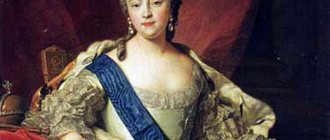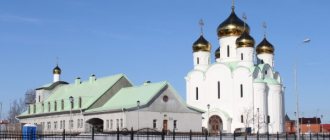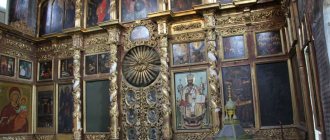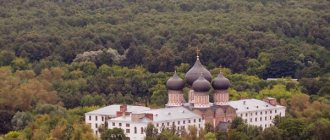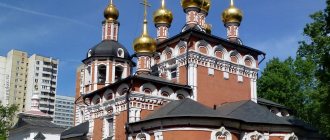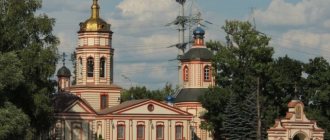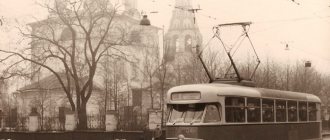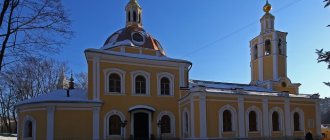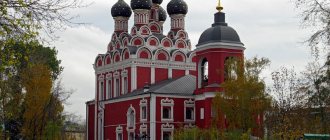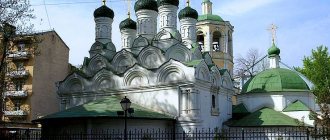Church of the Holy Great Martyr Demetrius of Thessalonica on Blagush . The beginning of its history dates back to the beginning of the twentieth century.
This event was preceded by an appeal from the residents of the Blagusha tract to Metropolitan Vladimir of Moscow: they asked for a special clergy at the church for nourishment and spiritual assistance to the parishioners.
In response to this, the Metropolitan invited those who applied to build their own church and allocated for the construction part of the amount donated by Honorary Citizen Dimitry Ermakov to the Spiritual Department back in 1896.
The Moscow merchant gave the confessors a rather large sum - about a hundred thousand rubles from his own inheritance.
The only condition of the patron was that the money should be used for the construction of the temple of Demetrius of Thessalonica, whom Ermakov considered his heavenly patron, and St. Righteous Anna, the patroness and protector of his wife.
With these events, the construction of the temple on Blagush began.
Temple of Demetrius of Thessalonica on Blagush today
The temple is located in the northeastern part of the Sokolinaya Gora district of the Eastern Administrative District of the capital. Blagusha is a historical area between the Small Ring of the Moscow Railway and the Semenovskaya Zastava. Previously, in those places there was a protected forest - Blagushinskaya Grove, where the royal court had fun with falconry.
People call the temple “Dmitrovskaya Church”, and its official name is the Church of the Great Martyr Dmitry of Thessalonica on Blagush. It belongs to the Moscow City Diocese of the Russian Orthodox Church, and since 2012 it has been part of the group of parishes of the Resurrection Deanery.
The Temple of Demetrius of Thessalonica on Blagush is named after the Christian saint who endured great torment for the Savior. He lived in the 3rd century, during the reign of the Roman emperors Diocletian and Maximian. Dmitry was a man of noble birth and served as proconsul in Thessaloniki (now Thessaloniki, Greece).
Temple of Demetrius of Thessalonica
For openly preaching the Christian religion, he was imprisoned and executed. The body was thrown to be devoured by wild animals, but they did not touch it. The remains were buried by local Christians. Later it was discovered that Dmitry’s relics were incorruptible, and fragrant myrrh flowed from them. The Holy Great Martyr was called the Myrrh-Breaking Church by the Church, and through the anointing with the flowing myrrh, many sufferers received healing.
Among the Slavic peoples, the Great Martyr Dmitry always enjoyed special veneration. The Russian princes prayed for his intercession before the battles with Mamai; it was he who became the heavenly patron of Dmitry Donskoy.
The Day of the Great Martyr Dmitry was one of the biggest holidays in Rus'. In Orthodox circles there has always been confidence in the Slavic origin of the saint, confirmed by some studies. In 1848, Bishop Filaret published an article in which he provided some justification for this conclusion.
In honor of the Great Martyr Dmitry of Thessalonica, the main altar of the temple for worship was consecrated. The left chapel of the church is dedicated to St. Peter the Metropolitan, and the right chapel to the Dormition of the Righteous Anna. The temple is quite large: it can accommodate about 3 thousand parishioners at a time.
Reconstruction and expansion of the parish
In the early 1840s, there was a need to expand the church, so two extensions were added to it for an additional altar, as well as a bell tower in the pseudo-Byzantine style, which resembled a minaret and thereby gave the area an “oriental” flavor.
The extensions made it possible to accommodate 800 people in the church. Interestingly, among the famous parishioners of the temple was the Kvitok family. Marya Vasilievna Kvitka lived not far from the temple and Grigory Fedorovich Kvitka-Osnovyanenko and his wife rented an apartment.
With the construction of the railway and station, as well as the settlement of the area, the former suburb of Goncharovka became almost the center of the city. Demetrievskaya Church again needed expansion. This statement was made by Archpriest John Chizhevsky. The parishioners supported him - in 1885-1896 the church was reconstructed according to the design of the architect Mikhail Lovtsov. The central nave was expanded, and the side aisles and bell tower were rebuilt. The temple combined elements of Gothic, Byzantine and Old Ukrainian decor. Now it could accommodate over 2,100 worshipers. The interior decoration of the temple was completed only in 1901.
The temple helped the Alexander Hospital, for which Father John Chizhevsky received gratitude from the Kharkov city government in 1894. In 1896, a parish brotherhood appeared, which was involved in the improvement of the church, the welfare of the clergy and provided primary education to the children of parishioners. In 1898, a school for girls was opened at the parish, and in 1899, a hospital for the elderly.
Architect, exterior decoration, architectural ensemble
The temple was erected between 1909 and 1911. Nikolai Ivanovich Orlov, a well-known architect in Moscow at that time, was invited to develop drawings and a construction plan. Among his projects are the Church of Catherine the Great Martyr in Rakhmanovo and the Kursk-Nizhegorodsky railway station building, which was later rebuilt.
Orlov was closely acquainted with the family of the philanthropist Ermakov, who donated money for the construction. He was also involved in the building of the Ermakov almshouse. The Temple of Dmitry of Thessaloniki became the last major project of the architect.
During the initial construction, the temple was made of red brick, complemented by green tiles. Now the walls of the temple are painted in the traditional white color for Russian Orthodox churches and decorated with red-brown trim. Black domes symbolize Christian humility, severity and sorrow for the Savior.
The architectural style is characterized by eclecticism: the ancient Greek and Russian foundations of temple construction, combined into a single whole, are intended to symbolize the connection between the spiritual feat of Dmitry of Thessaloniki and the military service of the holy noble prince Dmitry Donskoy.
The structure is a cross-domed building typical of Byzantine architecture, connected to a three-nave basilica. The interior decoration - the central chandelier, the marble altar, the mosaic floor and the white arches of the walls - create an impression of solemn severity.
Description of architecture and interior decoration
Several architectural styles were used in the construction of the temple. It contains Greek and Russian motifs - the cross-domed church is connected to a three-nave basilica. This symbolizes the unity of the spiritual path of two saints: Demetrius of Donskoy and his heavenly patron Demetrius of Thessalonica.
This technique of combining different historical forms and style elements in one building is characteristic of eclecticism. This was one of the popular trends in architecture of that time, and received a new impetus in its development starting in the 30s. 19th century. It replaced classicism and provided complete freedom of creativity for architects.
Story
By 1880 Blagusha was a wasteland. The state forest (Blagushinskaya Grove) had already been completely cut down by that time. With the advent of manufactories and brick factories, the area began to quickly become populated by working people, and by the end of the 19th century. The area was a densely populated outskirts of Moscow.
At that time, almost 10 thousand people lived in Blagush. There was a Church of the Resurrection of Christ at the Semenovskoye cemetery, but it was small and could not accommodate everyone. It was especially crowded on church holidays.
In 1905, Metropolitan Vladimir of Moscow received a petition from the residents of Blagushi to expand the existing Resurrection Church. Having delved into the situation, the Metropolitan decided that it would be right to build a new, spacious church there.
The temple on Blagush was supposed to be built with money bequeathed by Dmitry Ermakov, a hereditary merchant and famous philanthropist. After his death, 100 thousand gold rubles were transferred to the benefit of the Spiritual Department.
The money was intended by the testator for the construction of a church dedicated to Dmitry of Thessalonica, whom he revered as his heavenly patron. In addition, in the same church there should be a chapel dedicated to the mother of Christ, Saint Righteous Anna - named after the wife of the deceased. These conditions were fully met.
In 1906, the state allocated a plot of land for the construction of the temple, and by the beginning of 1908, Orlov prepared an architectural project.
The laying of the sanctuary took place in August 1909. Metropolitan Vladimir personally supervised the construction work. He also organized the collection of missing funds. Construction continued until 1911. The parish at the church, opened a year earlier, was led by priest Mikhail Preferansov.
The first public service with the celebration of the Eucharist - the Divine Liturgy - took place in June 1911. It was conducted by Metropolitan Vladimir himself. At the same time, the main altar was consecrated.
The temple existed for only 20 years. In 1931, the Soviet authorities closed the parish, and the building became subordinate to the OGPU. A gold processing plant was set up there: with smelting furnaces and an acid shop. The dome and bell tower were dismantled. Crosses, church decorations - everything was removed. The bells were taken away. The building itself suffered significant damage. The core of the temple, the base of the bell tower and the clergy house have been preserved.
In 1990, the building was returned to the Russian Orthodox Church. Initially, they didn’t even begin to completely restore it - they simply returned the domes, installed crosses on them and began holding services. The first rector of the newly acquired church was Archpriest Sergius Kosov. Through his efforts, a community was formed and repair work began.
In 2000, the parish was headed by priest Peter Lipatov, who continued the reconstruction. The drawings of the architect Orlov, preserved in the archives, helped restore the building to its former appearance. By 2001, services entered the statutory channel and began to be carried out at the main limit.
After the death of Father Peter Lipatov, a new rector was appointed - Archpriest Andrei Milkin.
Current state
Completely destroyed, deprived of all city communications, the temple building returned to the possession of the Orthodox Church in the early 90s of the last century. The acid and smelting shops thoroughly destroyed the walls of the building.
The site was contaminated and a seven-meter layer of soil had to be removed and replaced with other, healthy soil. If earlier the church building was made of red brick, now it has been plastered and painted.
A parish was formed at the church under the leadership and spiritual guidance of Archpriest Sergei Kosov. He was subsequently replaced by priest Pyotr Lipatov. They led the work to restore the shrine trampled by the Bolsheviks. On November 17 of the same significant year, the consecration and installation of crosses took place.
All further restoration work was carried out very quickly. Already in 2001, the temple became operational and the patronal feast was celebrated in its main chapel.
Consecration of the Demetrius Church by Patriarch Kirill
On February 26, 2012, on Forgiveness Sunday, the revived church was consecrated by Patriarch Kirill. His Holiness donated to the temple the ancient Theodore image of the Mother of God, revered by Orthodox believers as an assistant in childbirth. The Sunday school was also revived in the church, and the Orthodox Club of Historical Reconstruction was formed, where fencing classes began to be held.
Shrines and relics of the temple
The Temple of Demetrius of Thessaloniki on Blagush has more than 60 icons, some of them are supplemented with the relics of saints. Next to the icons you can find a sheet of paper with prayers to each of the saints. Among the images there are quite rare ones - icons of the Holy Martyr Uar and the Holy Venerable Elijah of Murom.
In the narthex, right in front of the entrance, there is an icon of the Most Holy Theotokos “Kazan”. On the left side of the narthex, believers can approach the icons “Rejoicing in You” and “Michael the Archangel”, on the right - “Christ the Savior” and “Archangel Gabriel”. In the right aisle there is the Cross of the Lord by Archpriest Gerasim Ivanov and the Small Cross with Calvary.
The main treasure is the ark with a particle of the relics of Dmitry Thessalonica, which in 2004 the Kiev Metropolis transferred to the temple. The reliquary with this priceless gift is located in the part closest to the altar, under the icon of the patron saint.
Patronal holidays[edit]
Demetrius of Thessaloniki, great martyr
— November 8 (death day)
Nativity of the Blessed Virgin Mary
- September 21
Onuphrius the Great, Rev.
— June 25
Peter of Athos, Rev.
– June 25
Clergy, mentors
Now there are several priests serving in the temple, who perform church services and educate parishioners:
- rector Andrei Milkin, archpriest (senior priest);
- Archpriest Victor Sarana;
- priest Igor Ivanov;
- priest Alexander Druzhinin;
- priest Andrey Krivonogov;
- Deacon Alexey Zavarnov.
Father Andrei Milkin graduated from a theological seminary in Nizhny Novgorod and was ordained a priest in 1999. He was a cleric in the Nizhny Novgorod diocese until 2011, then he was transferred to serve in the Moscow diocese and appointed rector of the Church of Dmitry of Thessaloniki.
The abbot's voice can be heard at lectures on Biblical history, which are held online. There is an opportunity to attend his classes in person. Father Andrey conducts a course of Bible conversations, helping parishioners to plunge deeper into the word of God and better understand the meaning of the Holy Scriptures.
Father Igor Ivanov also conducts classes on the study of the books of Holy Scripture as part of the Bible circle.
You can approach each priest and arrange a personal conversation and ask for advice. If there is a need in the heart for support and guidance in matters of spiritual life, any of the parishioners can find an experienced mentor or confessor in the person of one of the priests.
Activities of the parish
The composition of the temple's clergy is represented by several clergy. Its rector, Father Andrei Milkin, was appointed to this position on May 10, 2011. Other clergy also active here:
- prot. Victor Sarana;
- Hier. Alexander Druzhinin;
- Hier. Igor Ivanov;
- Hier. Andrey Krivonogov;
- diak. Alexey Zavarnov.
Central iconostasis of the Church of Demetrius of Thessalonica
When, after the restoration work was completed, services in the temple began to be held daily, many believers, and with them children, flocked here. A Sunday school began operating, in which there are several age groups:
- preschool;
- school;
- youth;
- adult.
The training is conducted by Priest Alexy Mityushin, who 2001-2013. was a cleric of this temple, and then transferred to the position of rector of the Church of the Life-Giving Trinity in Kozhukhovo.
Conversations held in Sunday school help children become churchgoers, build connections between the church and the world, and gain spiritual guidance. The adult group is taught the basics of faith by Father Igor Ivanov.
Parish and choir of the temple
The Temple of Demetrius of Thessalonica on Blagush is visited not only by Orthodox believers living in the Sokolinaya Gora area. Parishioners from different parts of Moscow regularly come to services and actively participate in the life of the parish.
Among the older parishioners there are people who took a personal part in the restoration of the temple after its transfer to the Russian Orthodox Church, who knew Father Sergius Kosov.
The church choir sings at all services in the church. The first director of the choir was Vasily Timofeevich Makarov. He graduated from the Music College named after. Gnessins in violin class, performed on tour. He came to serve in the church on Blagush when he turned 40 years old. He directed the choir. The story of this man repeated the difficult fate of the temple: Makarov was arrested on false charges and shot in 1938.
During the restoration of the temple, the choir director was Irina Vladimirovna Sarycheva, the granddaughter of Archimandrite Daniil Sarychev. In Soviet times, before his monastic vows, he also served as a regent in various churches and organized church choirs. Irina Vladimirovna was involved in managing the choir until she entered the monastery.
For some time, the choir was led by Grigory Zhezhel, who at the same time headed the vocal ensemble “Melos”. Its musicians are engaged in the reconstruction and performance of ancient music of Western Europe, Russia and Georgia. Together with the choir of the Church of St. Demetrius of Thessaloniki, he recorded a collection of spiritual chants “Pilgrimage”.
Now the regent is conductor Natalia Evtyukhina. The choir is mixed, that is, it consists of male and female voices.
Church of the Holy Great Martyr Demetrius of Thessalonica
Church of St. Demetrius of Solunsky in Moscow was located on Tverskaya Street on the corner with Tverskoy Boulevard, where a gray house with the “Armenia” and “Seafood” stores now stands. The church stood like this: the church itself was on the site of the “Armenia” store and Konenkov’s museum-apartment on Tverskoy Boulevard, and the tented bell tower was on the site of the confectionery shop on Tverskaya Street.
Church of the Holy Great Martyr Demetrius of Thessalonica at the Tver Gate and Passion Monastery
In Rus', St. Great Martyr Demetrius of Thessalonica was revered as the patron of patriotism and all those who fight for the Fatherland. A faithful Christian, he was appointed by the Roman Emperor Galerius as proconsul in the Thessalonian region during the period of persecution of Christianity at the turn of the 3rd–4th centuries. However, contrary to Roman policy, he did not persecute Christians, but began to eradicate paganism. For this, the twenty-year-old youth was imprisoned and killed there with spears in 306.
The veneration of the martyr, the “ancient sufferer for the Fatherland,” began in Rus' immediately after its adoption of Christianity. In the 70s In the 11th century, the Dimitrievsky Monastery was founded in Kyiv, and in 1197 the miraculous icon of St. Demetrius, written on a board from the saint’s tomb (now it is in the Tretyakov Gallery). The saint is depicted in military armor with bird feathers, with a spear and sword in his hands. In Moscow he was also revered as a defender in the battle against foreigners. Thus, the day of the Angel Dmitry Donskoy and the glory of his victory on the Kulikovo field were attributed to the Thessalonian saint. According to legend, the parental or “grandfather’s” Saturday before his holiday on October 26 (November 9, new style) was established by Dmitry Donskoy himself.
Chapel in the name of St. Demetrius of Thessalonica was founded in the Kremlin Assumption Cathedral under Ivan Kalita. In 1326, Grand Duke Yuri Danilovich, Kalita’s brother, who was killed in the Horde by the Tver prince in the struggle for the khan’s label for the great reign, was buried in the newly founded temple. Then Moscow received it, and the prince, killed for the Fatherland, was buried in the Dimitrievsky chapel of the Assumption Church. There is a version that the Dimitrievsky chapel itself was built over the burial of the Moscow prince. And the Cathedral of the Archangel Michael, which became the grand ducal and royal tomb, did not yet exist in those years.
Stone bas-relief depicting St. Demetrius of Thessalonica in 1462 also appeared on the main Kremlin gate - on the inside of the Spasskaya Tower from the Kremlin side. And on the outer side of Red Square they placed an image of St. St. George the Victorious by the same master – Vasily Ermolin. Thus the city was given over to the protection of the martyred soldiers. Both bas-reliefs were removed during the reconstruction of the tower in 1491 by the architect Pietro Solari: Georgievsky was transferred to the Kremlin Ascension Monastery, and Dimitrievsky probably died, as pre-revolutionary local historians believed.
Church of the Holy Great Martyr Demetrius of Thessalonica at the Tverskaya Gate
It is no coincidence that the Moscow church in honor of St. Demetrius of Thessalonica as a specific state symbol was built on Tverskaya Street - the main road of Moscow leading to the Kremlin. In the 14th-15th centuries, the Kiev-Pechersk courtyard was located on this site, and the old Sovereign’s country house stood nearby.
It appeared even before the Romanovs, and in the first half of the 17th century it was already two- or three-tented, similar to the neighboring Church of the Nativity of the Virgin Mary in Putinki on M. Dmitrovka. Consequently, the Dimitrievsky Church was definitely built before 1648, because the same type of Nativity Church that appeared that year was the last in Moscow built in the tent style before the decree of Patriarch Nikon banning the construction of tent churches and the widespread transition to cross-domed ones (this decree will be canceled already in the second half of the 17th century after the expulsion of Nikon.)
From that time until the revolution, the tented bell tower survived. The temple itself was rebuilt in 1791.
The point was this. According to the reconstruction, the church was supposed to become a certain architectural solution to the composition of Strastnaya Square and Tverskoy Boulevard - the first in the ring, built on the site of the White City fortress wall that was broken at that time.
By the middle of the 18th century, this wall had already lost its fortification significance. The gates of the White City were no longer locked at night, as in the old days, and were not guarded. And Muscovites stole bricks from the dilapidated wall for their own needs. Since the 1760s, the stones and bricks of the White City, with the permission of the city authorities, were used for the construction of government buildings: the Orphanage and the house of the Governor General on Tverskaya. As a result, part of the White City wall one day collapsed and crushed several passers-by. After this incident, it was finally decided to demolish the medieval building.
The Stone Order, created specifically for this purpose in June 1774, under the leadership of Prince M.N. Volkonsky received an order: to destroy the fortress walls and plant trees in their place. This is how the boulevard ring was created. History has not preserved the author of the idea, but it is attributed to Bazhenov, Rastrelli or Starov.
First, in the area from Nikitsky to Petrovsky Gates, they demolished the wall, filled in the ditch, planted small trees, which soon dried up, and that was the end of the matter. Only under Paul I, in 1796, under the leadership of the architect S. Karin, the first Moscow boulevard, Tverskaya, was laid out.
Along with it, the foreign word “boulevard” appeared in the Russian language: it was borrowed from the French “boulevard”, and came into French from the German “Bolwerk”, which means “fortress wall”. The custom of arranging alleys bordered by lawns, trees and bushes on the site of abolished fortress walls has long been known in France. The part of the territory where the city wall passed became a green strip. The same thing happened in Moscow. Until the middle of the 19th century, Muscovites called the innovation either a “boulevard”, or “boulevard”, or “boulevard”, and among the common people even “gulvar”, explaining: “If people walk on it, it means it’s a gulvar.” Indeed, immediately after its birth, Tverskoy Boulevard became a favorite walking place for Moscow high society. Along its entire length it was decorated with many lanterns and graceful bridges.
In the Nicholas era, mulberry trees were planted on the boulevard, giving leaves late. In the spring, the emperor himself came to Moscow and early in the morning he went for a walk on the boulevard. He drew attention to the strange “sticks” and immediately Governor General A. Zakrevsky ordered the firefighters of the Tver department to remove these trees that same night. The next morning he reported to the emperor: “Your Majesty, the boulevard has been cleared of sticks!”
After Napoleon's army left Moscow, Tverskoy Boulevard had rivals - new, broken boulevards. However, he was so much more popular than them that they often simply said “Boulevard”, and it was clear that they were talking about Tverskoy.
So, in relation to the new look of the city, they began to rebuild the Dimitrievskaya Church, which stood next to the boulevard in the place where the parade exit to the Kremlin began. Its main altar was consecrated in the name of St. Trinity, and the chapel - in honor of St. Demetrius of Thessalonica.
Two great rarities distinguished this church from other Moscow churches. One of them is an ancient hipped bell tower, which was much older than the church building itself. It survived until the revolution, despite the many-pound bells and their daily swinging for hundreds of centuries. Another rarity is the image of the Savior on the apse, which was previously located on the Tver Gate of the White City - according to Russian custom, placing images on the fortress gates to protect the city from enemies and disasters. When the wall was dismantled, this image was moved exactly here, to the Demetrius Church.
Church of the Holy Great Martyr Demetrius of Thessalonica at the Tverskaya Gate
And even at the beginning of the 19th century, the church was famous for its choir. Muscovites from all over the city gathered here to listen to him, especially during holiday services. Noble people also came here. Often there were so many of them that the carriages stood along the entire boulevard.
And when the merchant Eliseev built his famous store with a wine department right opposite the church, an excise official soon came to him - so, trade is illegal, because a wine cellar can be located at a distance of no closer than 42 fathoms from the entrance to the temple, but here this rule is not observed . There was only one entrance to the grocery store back then, from Tverskaya Street. Eliseev persuaded the official to wait until the morning. Work was in full swing all night, and a few meters were gained: the next day, a wine store with a separate entrance appeared on Kozitsky Lane, where it is located to this day.
Church of St. Demetrius of Solunsky was destroyed during the reconstruction of Tverskaya Street in 1934. The story of its demolition is a separate chapter in the sad chronicle of the ancient Moscow temple. At first it was planned to demolish only the bell tower. Then, in 1932, the temple was included in the list of churches to be demolished, but the authoritative public stood up for it. Among the defenders was P.D. Baranovsky. At first they asked to preserve the tented bell tower - Baranovsky prepared a plan for its relocation - but in the end everything was destroyed.
Instead of the temple, a huge residential building No. 17 was built according to the design of the architect A. Mordvinov. On the corner turret of the house - the new architectural “dominant” of the square - there used to be a huge statue of a ballerina with her leg raised high and her hand raised to the sun. There was a lot of jokes about her in Moscow. In 1958, the sculpture was removed - the dilapidated “Ballerina” threatened to fall on the heads of passers-by at any moment.
Social work, everyday life
The parish of the temple carries out active social work. Since 2016, regular support has been provided to the residents of the Novinki children's psychoneurological sanatorium, located in the Tver region. Church parishioners and Orthodox volunteers visit the Noah social shelter in Yegoryevsk.
Fundraisers are held for the benefit of needy parishioners. Sick, lonely people, large families are provided with all kinds of help.
In the “Green Living Room” of the Parish House, literary evenings and meetings with famous poets, writers and musicians are held for parishioners.
Sunday School
In 2001, the Sunday School opened its doors to students. Classes are attended by children of parishioners, starting from preschool age. The guys are divided into two groups: junior and senior.
Under the supervision of experienced Orthodox teachers, children receive basic knowledge of Church history, Biblical history, Liturgics and Catechism. The older group takes classes in the Church Slavonic language. Kids study disciplines such as temple studies and the Law of God.
The school has creative workshops. Children are taught drawing, modeling, and bead weaving. Pupils prepare theatrical performances, which they perform at festive events.
Excursion trips to holy places are organized for children.
Second wind
Every day many believers or those who are still only seeking God come to the temple. And this cannot but rejoice. After all, the spiritual purity of each of us makes society as a whole more spiritual and purer. There is a Sunday school at the church. Classes are held with different age groups: preschoolers, younger students and youth. Their main goal is to help children learn to distinguish good from evil, maintain a pure consciousness and conscience, and remain “children of God” even when they become adults. Naturally, children are also given the basics of knowledge of the Orthodox faith and culture. Classes are also held for older parishioners. Church servants perform many useful missionary works, visiting various social and medical institutions (orphanages, boarding schools, sanatoriums, hospitals, nursing homes, etc.). The parish priests are also frequent guests in prisons: sinful hearts need the word of God even more than the righteous. Consolation, support, wise advice, cleansing prayers - the temple servants generously share all this with everyone who needs it.
Patronal holidays
The church celebrates 3 patronal feasts, according to the number of thrones:
- November 8 is the day of remembrance of the Great Martyr Dmitry of Thessalonica.
- August 7 is the day of the Dormition of Righteous Anna. The Lord gave this pious woman and her husband a daughter when they were already in old age. The girl was named Mary, she became the mother of the Savior of the human race.
- January 3 is the day of St. Peter, the first Moscow metropolitan. In 1325, Saint Peter transferred the metropolitanate from Vladimir to Moscow and did a lot to unite the Russian principalities.
Dates are based on the Gregorian calendar.
Service schedule, operating hours
Divine services are held daily. The temple opens from 7:30 on weekdays and Saturdays. On Sundays and holidays, the temple doors are open from 6:30.
| Days of the week | Divine services |
| From Monday to Friday inclusive | 08:00 — Divine Liturgy. Prayer service. Funeral lithium. 17:00 —Evening services and Matins. |
| On Saturdays | 09:00 — Divine Liturgy. Memorial service for the departed. 17:00 — All-night vigil. |
| On Sundays | At 7 and 10 am - early and late Divine Liturgy. Prayer service. 17:00 — All-night vigil or Akathist. |
To have access to the current schedule of services, you can install a special software application on your phone or computer. The link to download it is on the temple website.
Pilgrim[edit]
Schedule of services:
Morning services: Confession at 8.00, Liturgy at 9.00
Evening: at 17.00
On weekdays (Monday - Saturday) our temple opens at 7:30, and on Sundays and holidays - at 6:30
The Blessing of Water prayer is performed on Sundays, after the early Liturgy.
On Sunday evening, if there is no polyeleos service, an akathist to the Great Martyr Demetrius of Thessalonica is served.
Those wishing to get married must come to a conversation with the priest.
If you have any questions related to the schedule of Divine services, please contact us by phone
(495) 365-31-61.
worship services for a week
Website:
https://hramdimitria.ru/
Interesting Facts
The Temple of Demetrius of Thessalonica on Blagush, or rather its dilapidated building, could have been completely destroyed in the early 90s. after the removal of the plant located in it from Moscow. Fortunately, there were people who defended him. Other remarkable facts and events are also associated with the temple.
- Another Moscow church dedicated to Dmitry of Thessalonica is located in the same Resurrection Deanery, in the village of Vostochny. It was erected in 1996. The architectural basis was the drawings of the destroyed 19th century temple that stood on that site.
- The father of the man who donated a huge amount of money for the construction of the temple was also a famous Moscow philanthropist. This was the merchant and manufacturer Flor Yakovlevich Ermakov, a former serf who became a philanthropist and received the nobility. In the middle of his life, he retired from business due to the sadness that befell him after the death of people close to him, and devoted himself to good deeds. Flor Yakovlevich rebuilt his factory in Sokolniki into an almshouse for peasants. With his funds, a shelter was opened, a vocational school was built, and the Assumption Church in Kolomna was restored. For his noble deeds he was awarded the title of nobility.
- Two great people at once performed divine services within the walls of the temple on September 23 (September 10, old style) 1923 - Patriarch Tikhon, who pronounced an anathema on the Bolsheviks in 1918, and Archbishop Hilarion of the Trinity. Both suffered during the persecution of the Church, both were canonized by the Council of Bishops of the Russian Orthodox Church at the end of the 20th century.
- An unpleasant incident happened in the summer of 2013: the temple was robbed. The gold frames were removed from several icons. The criminals were later detained.
Current state[edit]
In the summer of 1989, at the request of parishioners, the temple was transferred to the Russian Orthodox Church. Divine services and its restoration began in the temple.
The parish church of the Holy Great Martyr Demetrius of Thessalonica was initially consecrated by the priestly rank in June 1989, and then on August 29, 1993 - by the bishop's rank of the ever-memorable Most Reverend Eugene, Archbishop of Tambov and Michurinsky. The side altars of the church in honor of the Nativity of the Blessed Virgin Mary and in honor of St. Peter of Athos and St. Onuphrius the Great were consecrated with the blessing of His Eminence Theodosius, Bishop of Tambov and Michurinsk on June 22, 2003.
On the territory of the temple in 1993, a church house was built, in which there are: a baptismal room, a refectory, a prosphora, a hotel, a meeting room, gas boiler houses, churches and houses; in the basement there is a garage, warehouses, and a solid fuel boiler room.
From 1994 to 1998, wall paintings were carried out in the temple; in 2010, work on the central iconostasis was completed.
In 2002, an overhead chapel was erected in honor of the icon of the Most Holy Theotokos “Life-Giving Source”.
Since 2004, an Orthodox library has been operating in the building of the secondary school next to the church.
On July 10, 2015, the opening and consecration of the monument to the holy Great Martyr Demetrius of Thessalonica took place on the territory of the temple. The rite of consecration of the monument was performed by His Eminence Hermogenes, Bishop of Michurinsky and Morshansky.
Information for pilgrims
You can come to confession and communion every day. At 8 a.m. the sacrament of communion and confession are performed on weekdays. On holidays - at 7 and 10 am.
Tours are available in the temple. There is a ramp for people with mobility difficulties. On the temple grounds there are parking lots for strollers and bicycles, as well as resting areas where you can sit.
Guests of the temple praise the refectory, where home-cooked food is served very inexpensively: soups, cold and hot snacks. The shop sells homemade cakes and pastries.
Where is it located, what is in the surrounding area, how to get there
The temple is located on the street. Ibragimova, house 6. The nearest metro stations are “Semyonovskaya” and “Partizanskaya”. Both are located on the Arbatsko-Pokrovskaya line. The straight line distance from Semenovskaya to the temple is only 790 m, from Partizanskaya - 1360 m.
To get to the temple, it is better to take tram 11, 12 or 34. From the Partizanskaya metro station you will have to go 4 stops, and from the Semenovskaya metro station - one. Also from the Partizanskaya metro station there is bus 36 (2 stops) or 634 (4 stops). You should get off at the “Ulitsa Ibragimova” stop.
Not far away, on Shcherbakovskaya Street, there is a restaurant of national cuisine “Gurman” and a khinkal restaurant “U Bekho”. The Izmailovsky market is located 2 km from the temple. You can enjoy outdoor recreation in the nearby Brateevsky Park. Walking around the territory of the Izmailovo Natural and Historical Park will bring great pleasure. The House of Fairy Tales “Once upon a time,” which is located just 100 meters from the temple, conducts educational excursions for children in the format of interactive performances.
Destroyed in the era of victorious atheism and resurrected again, now the Church of Dmitry of Thessaloniki is not only a place of spiritual communication of parishioners with God, but also one of the most significant historical and architectural attractions of the capital, a valuable Blagushinsky decoration.

